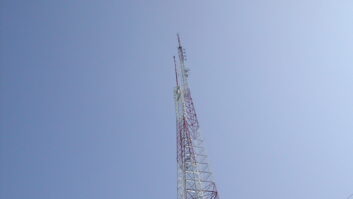“‘Somewhere Up There, the Major’s Looking Down and Saying ‘Woo-Hoo!'”
No, it wasn’t a ghostly voice from beyond echoing into the New York metropolitan airwaves at 42.8 megacycles. It was the voice of WINS(AM) morning news anchor Judy DeAngelis, testing the microphone just before noon on Saturday, June 11 for the first broadcast on the old 42-50 MHz FM band in more than half a century:
“Somewhere up there, the Major’s looking down and saying, ‘Woo-hoo!'”
DeAngelis was expressing a sentiment shared by 130 people who packed the historic Alpine, N.J. tower site built by Major Edwin Howard Armstrong in the 1930s.
The invitation-only crowd was assembled by CSC Management, the tower company that has owned the distinctive triple-masted Armstrong tower for decades. The organizers even had to implement a waiting list for the event.
And while the ostensible purpose for the get-together was to mark the 70th anniversary of Armstrong’s first FM broadcast tests in 1935, it was really a long-delayed overall honor for one of America’s true radio inventor-heroes.
Major fans
Confessions: I’ve been a fan of Major Armstrong for years, and as the 50th anniversary of his death approached in February 2004, I harbored more than a passing thought about driving the six hours to Manhattan and carrying a candle in front of the East Side apartment building where Armstrong committed suicide in 1954.
(click thumbnail)Mark Humphrey snaps a photo of the original Armstrong building. — Photo by Scott Fybush
Other events got in the way, but it turns out that if I had made the drive, I wouldn’t have been alone. I later learned that a small crowd had assembled on East 52nd Street that night, candles and all, and among them was Philadelphia engineer Steve Hemphill, owner of Solid Electronics Laboratories.
You’ve seen Steve in these pages before, most notably for an honorary “Cool Stuff” Award he received for the replica Phasitron FM exciter he built and displayed at NAB2002. And while the Phasitron wasn’t an Armstrong invention (and indeed, was never used on the old FM band), the little memorial gathering that night inspired Steve to start building a Phasitron that could be used down the dial at Armstrong’s original frequency.
Another stroke of luck brought Steve together with Charles Sackermann Jr., president of CSC and another huge fan of the Major’s.
Sackermann and his crew at CSC provided Steve with space at Alpine to install the transmitter and to mount an antenna high on the tower. It also didn’t hurt that the old FM band had, by the turn of the century, been largely vacated by the two-way users who occupied it after FM was kicked “upstairs” to its present 88-108 MHz band, thus providing room on the dial for the FCC to grant a Special Temporary Authorization for a little bit of broadcasting to return to the old band.
A few lucky engineering types learned about Steve’s project during a meeting of New York City’s SBE Chapter 15 held at the Alpine site last winter, when the sounds of classical music could be heard wafting from an old Stromberg-Carlson console radio at the back of Armstrong’s building, tuned to 44.1.
“Aha,” I remember thinking when I saw the radio, “someone’s cleverly hooked a CD player up to this radio. Sounds nice!”
It was, of course, far more clever than that; and by the end of the night a cluster of engineers had assembled around the Phasitron transmitter, in one of the rooms of the new transmitter building built at the base of the tower, ooh-ing and ah-ing over Steve’s incredibly detailed construction work – and over the Tivoli Model One table radio that Steve had cleverly modified to tune the old FM band as an air monitor. (It was also undoubtedly the first time an Optimod had been used on the old FM band. Somewhere in California, Bob Orban might also be looking east and saying woo-hoo.)
Flash forward, then, from that frigid January night to a sweltering June afternoon.
They were there
The STA for 44.1, under the calls W3XXE, had been replaced by 42.8, after appropriate clearances had been obtained from the public-service users still on the channel elsewhere in the country. Armstrong’s original calls, W2XMN, were in use by the Armstrong Memorial Radio Club, but the appropriate calls “WA2XMN” had been obtained in their place.
Instead of the crowded meeting room on the second floor of the Armstrong building, the activity had moved out to a tent on the lawn, with big-screen monitors showing the dais that had been set up inside the building for an hour-long panel discussion of Armstrong’s legacy.
A few minutes before noon, Steve flipped the ceremonial switch to put the 42.8 signal on the air, and the memorial was underway.
(click thumbnail)Site owner Charles Sackermann Jr., right, is presented with a Zenith dual-band FM radio for the museum.— Photo by Scott Fybush
For an hour, DeAngelis talked with living veterans of Armstrong’s era, including Renville McMann, who began working for the Major when he was 13; Henry Dietz, who worked for Radio Electronics Labs, which made receivers and other equipment for Armstrong; Jerry Minter, who was present at Alpine when the station (by then operating as KE2XCC on 93.1) signed off for good in 1954; and Robert Brecht, an Armstrong family descendant.
Also taking part in the broadcast were Hemphill, Sackermann, engineer Gilbert Houck, a nephew of Armstrong’s colleague Harry Houck, and Mike Katzdorn, who created a comprehensive Armstrong Web site. The program was simulcast on WFDU 89.1 MHz, the Fairleigh Dickinson University station that transmits from Alpine.
It was an emotional broadcast, never more so than when Hemphill spoke of his admiration for the Major.
“Every dime I’ve made, every project I’ve done has come from him … and I owe him a great deal,” Hemphill said.
WA2XMN remained on the air for three more hours that afternoon, carrying interviews with other Armstrong relatives and with Tom Lewis, author of “Empire of the Air,” the definitive story of Armstrong’s rivalry with David Sarnoff and Lee DeForest.
While the broadcast played, the engineers and other Armstrong fans roamed the grounds, admiring the shrine to early radio that the Sackermanns have built inside the original W2XMN building. For the day, the displays included some very early Armstrong gear, such as the master oscillator used in the Major’s earliest FM tests from the Empire State Building.
There was barely a moment when someone didn’t have a camera pointed at the tower, the building or at a grinning fellow guest standing on the steps of the building.
“This is like a wedding reception for radio people,” said one attendee.
By 3:45, the crowd had begun to thin, as a relaxed Hemphill stood on the lawn talking with McMann and other guests about the earliest days of FM. As the WA2XMN broadcast wound down with the final moments of the “Empire of the Air” radio drama, eyes moved towards the tower as a recording of the final sign-off of KE2XCC played.
“As we prepare to pull the switch and shut the station down, we salute the memory of Edwin Howard Armstrong.”
Just as KE2XCC had done a half-century before, WA2XMN went silent, but with less of a sense of finality. With FCC authority to operate until September, it’s likely that 42.8 will be active again, at least on occasion, this summer. Better yet, there’s talk about what might be done in a few years to commemorate the 75th anniversary of FM radio – perhaps even a recreation of Armstrong’s FM networking experiments from mountain peak to mountain peak in New England.
“It’s nice to finally see some recognition go back to Armstrong,” said Sackermann after the event.














